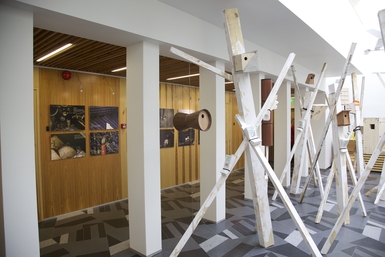Exhibition – Who comes to nestboxes?
Photo and text Tiit Hunt, www.rmk.ee
Translation Liis
In the RMK Tallinn office atrium at Toompuiestee 24 the exhibition ”13 tihast” is open on workdays until May 21st. Modern nestboxes - the works of first year Interior Architecture students at the Estonian Academy of Arts - and photos by Tiit Hunt of birds inhabiting nestboxes are shown.
Men have attracted birds to breed at their houses already since ancient times. In the old days their singing was probably not very important, but their eggs were an important food supplement.
The purpose of installing nestboxes has changed over times. During the last century nestboxes by hundreds were set up in forests, as a means of reducing the number of timber pests: birds should be useful. Today nestboxes are placed in trees in the garden or on the walls of houses, saunas or toolsheds so that the nesters as neighbours can delight us.
The bird species that come to breed in nestboxes make their nests in nature mainly in tree hollows, crevices and cracks. Old nest hollows made by woodpeckers are luxury homes for many passerines. We have nearly 30 such bird species.
Besides the starlings and great tits familiar to all, the most common settlers in nestboxes in a home garden are sparrows, pied flycatchers, blue tits, swifts and redstarts.
Traditionally nestboxes for birds are set up in spring before the arrival of the first spring heralds, and rightly so. During the spring breeding season they really are used as intended, but nestboxes can also be used during other seasons and for other purposes. The pygmy owl for instance picked tits from the birdfeeder for garden birds and filled the starling’s nestbox to the brim with them as a food store. Some birds come to nestboxes in winter to spend the night. Squirrels, bats, mice, wasps and others also use nestboxes for breeding and for shelter.
Let us make life easier for our feathered friends with a home-made nestbox!









